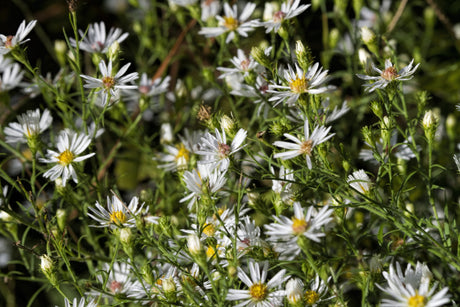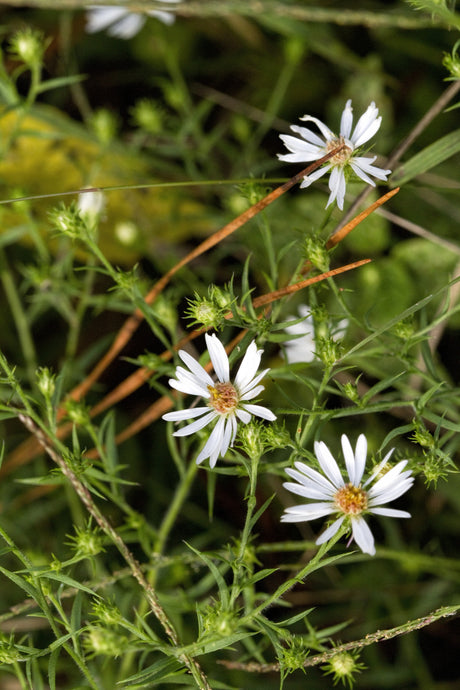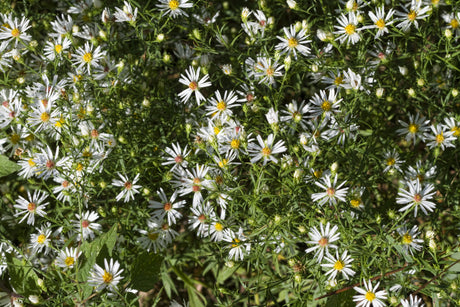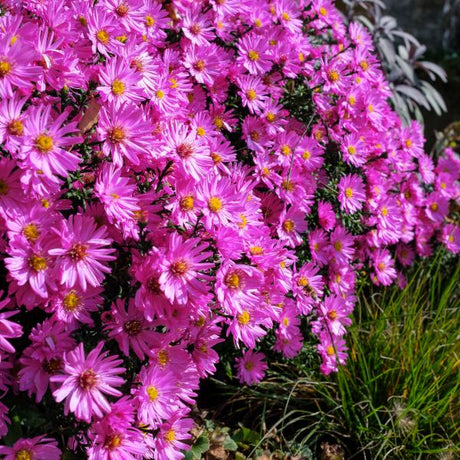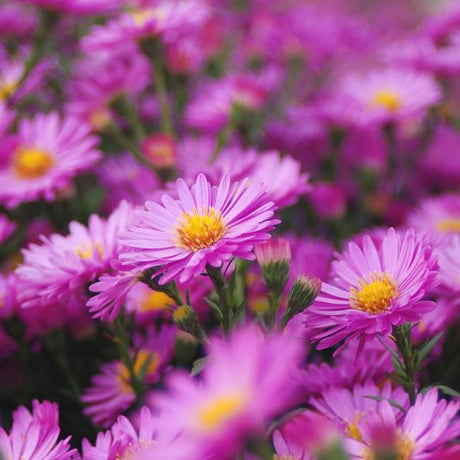- Sold out15% offSale price $2750 Regular price $3250Unit price /Unavailable
- Sold outRegular price $4968Unit price /Unavailable
Late Bloomers - Buy Aster Plants at Nature Hills!
The Aster plant has about 180 different species in the United States, and with the variety of choices, you can find a plant for almost any garden!
 Derived from the Greek word that means "star" the Aster lives up to its name with lacy flowers that are star-shaped and resemble a Daisy with more numerous little slender petals!
Derived from the Greek word that means "star" the Aster lives up to its name with lacy flowers that are star-shaped and resemble a Daisy with more numerous little slender petals!
Available in a variety of colors, these shy Perennials may go unnoticed all growing season until the end of the summer and fall! That's when the needle-like green leaves become more than just bushy greenery when they explode into drifts of vibrant blossoms with bright yellow centers!
This explosion is exactly when it is most needed since other flowers begin to fade! You gain fall color late in the season, and your pollinators that are looking for a late-season nectar and pollen resource - especially Monarch Butterflies gearing up for migration.
Asters In Your Garden
 There are many uses for this brightly colored flowering plant. Until it is in bloom, the mounds or airy clumps are fantastic landscape fillers and backdrops for their earlier flowering perennials or garden plants.
There are many uses for this brightly colored flowering plant. Until it is in bloom, the mounds or airy clumps are fantastic landscape fillers and backdrops for their earlier flowering perennials or garden plants.
Use in Cottage and Perennial borders, Rock Gardens, or in a special area that has the sun to part sun! A must-have for Cutting Gardens and no-brainers for the Pollinator Borders! Native forms of the Aster handle a wide variety of conditions from wet to xeric, bees, butterflies, and other beneficial insects rely on these little powerhouses!
Smaller plants can be planted in containers and mixed planters!
Perennial Aster Care
Caring for Aster plants is quite easy if you follow a few simple tips and procedures.
It is best to plant these Perennials in the spring, but you can plant them at any time during the growing season. Choose a location in well-drained soil that is exposed to full sun to light shade.
Even though Asters are drought-resistant, they need regular watering only during their first year until they are established. Water in the mornings and avoid wetting the leaves since this plant is susceptible to leaf fungus.
Fertilize sparingly, and mulch the root zone 3-4 inch deep layer of mulch to hold in moisture and insulate the roots.
If you want a thick plant with a blanket of blooms, cut stems to half their size in mid-July. This will encourage a bushier plant and more blooms! Once the plant has finished blooming or frost has killed back the tops, cut it to the ground and cover the crown with a layer of mulch. Asters do appreciate being divided every 3-5 years.
The best part of this fine-textured perennial is that it is reliable and comes back year after year!
FAQ's for Buying Aster Online
When do Aster plants bloom?
When do Aster plants bloom?
Asters are renowned for their late-season blooms, typically flowering from late summer through fall. They provide vibrant color just as other perennials begin to fade, making them a vital source of nectar for Monarchs and other migrating pollinators.
Do Asters come back every year?
Do Asters come back every year?
Yes, Asters are hardy herbaceous perennials that return year after year. With proper care and division every 3–5 years, they can continue to thrive and bloom beautifully in your garden for decades.
Where is the best place to plant Asters?
Where is the best place to plant Asters?
Plant Asters in full sun to partial shade in well-drained soil. They perform well in pollinator gardens, cottage borders, rock gardens, and even containers, offering flexibility for any landscape.
How do you keep Asters blooming longer?
How do you keep Asters blooming longer?
To extend the bloom time, deadhead spent flowers and cut stems back by half in midsummer to encourage bushier growth. Asters appreciate consistent moisture during their first year and benefit from mulching to retain soil moisture and suppress weeds.
Are Asters drought tolerant and pollinator friendly?
Are Asters drought tolerant and pollinator friendly?
Yes, once established, Asters are drought tolerant and incredibly pollinator friendly. Their daisy-like blooms attract bees, butterflies, and beneficial insects, making them an essential addition to any eco-conscious garden.

